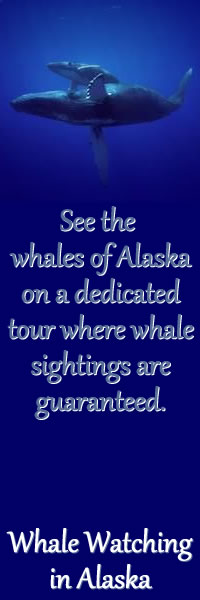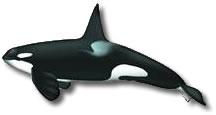 |
Alaska whale watching tours allow the visitors an opportunity to observe and photograph Humpback, Orca, Gray, and Beluga whales, along with many other marine mammals, in their natural environment. |
 |
|
Captains Choice Whale-Watching-Alaska.com |
 |
 |
|
 |
|
Orca Whales, Killer Whales of AlaskaAlaska Whale Watching Tours, Orca or Killer Whale Identification. Killer whales, also known as Orcas, are not really a whale at all but are members of the dolphin family. They are the largest, fastest and most powerful members of the dolphin family. They are called killer whales because they are great hunters. They are a member of the toothed whale group of marine mammals. Males can be as much as 30 feet long and weigh up to 20,000 pounds while still being able swim at a top speed of 30 miles an hour. This allows them to move 75 miles in a day, but is not typical. They are social animals and live in family-related groups known as pods. Pods may have of up to 40 members, made up of both males and females. They are protective of their young. Most of the care for the calves is provided by various pod members not just the mother. When the pod swims together the females and young ones stay to the center with the males surrounding them.
They are curious about humans much like other dolphins are and have been quickly trained to do tricks when brought into captivity. Trainers believe them to be much more intelligent than other kinds of dolphins. They are believed to have all the senses of humans with the exception of smell. To sleep they take catnaps on the surface of the water. During the summer months, from June to September, the northern resident whales can generally be seen from northern Vancouver Island to Alaska. They prefer to live in coastal waters in cooler regions. One thousand have been identified and photographed in Alaskan waters. Transient whale pods can be seen all along the western coast of North America, from Glacier Bay in Alaska to the southern California coast. They are also prevalent off the Aleutians. Some killer whales ride cold currents south in the winter months. The whales are easily identified by their extremely distinctive jet-black bodies and white patches usually over the eyes, under the jaw, on the belly, and extending onto their sides. Their tail fins stick up out of the water as they swim close to the surface. Each killer whale pod has its
own unique sound or dialect. They can easily recognize their own pod from several miles away based on the differences
in calls. Killer Whales, Orca.The orca or killer whale is readily identified. With it's pointed dorsal fin of up to 6 feet tall and shinny black and white white bodies typically sporting a white patch behind the eyes. Common names: Orcas, aka Killer Whale Orcas found in Alaska's waters by region and numbers: Seward Alaska: The best (Orca) killer whale viewing out of Seward is from May 5 - June 5 during which period several pods of orcas are found feed on a small king salmon run that congregates south of Seward. Background - Alaska Dept. Fish and Game: During the 1980s, photo identification techniques were used for the first time in Southeast Alaska and in Prince William Sound to determine the number of individuals and pods of killer whales occurring in those two areas. Following the Exxon Valdez oil spill, these studies were expanded and carried out on a more systematic basis. As a result of this research, Because some areas of Alaska have never had any photo identification research done, substantial numbers of killer whales may remain to be identified and counted. Resident Killer Whales in Alaska.Prince William Sound: approximately 250 animals in 15 pods. With powerful bodies, sharp minds, and the ability to work together like well trained soldiers, killer whales, also called orcas, can hunt down and kill virtually any living thing in the sea — including great white sharks and the largest creature to ever live, the blue whale. Whale Watching Alaska | Whale Watching | Whales in Alaska | Whale Watching Tours | Killer Whales Here on Whale Watching Alaska you will find information on Alaska whale populations, distributions and over all health. gray whale, killer whale, humpback whale, beluga Experience Juneau, Alaska Whale Watching trips and tours and discover the difference. Personalized whale watching tour. 1 to 6 passengers. This is your Alaska tour, done your way. See a large selection of quality Alaskan whale watching trips in Juneau, a leading one stop tour operator for adventure and exceptional Alaska travel. Numbers obtained from the Alaska Dept. of Fish and Game. |

 They eat sea
lions, fish, squid, seals, penguins, dolphins, porpoises and large whales like the blue whale. Resident pods
that live in primarily in one area seem to prefer fish whereas pods that are more transient prefer a variety
of marine animals. They are successful hunters because the whole pod participates and works together while hunting.
They eat sea
lions, fish, squid, seals, penguins, dolphins, porpoises and large whales like the blue whale. Resident pods
that live in primarily in one area seem to prefer fish whereas pods that are more transient prefer a variety
of marine animals. They are successful hunters because the whole pod participates and works together while hunting.